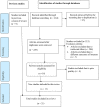The prevalence of pelvic organ prolapse and associated factors in Ethiopia: a systematic review and meta-analysis
- PMID: 37476611
- PMCID: PMC10354282
- DOI: 10.3389/fmed.2023.1193069
The prevalence of pelvic organ prolapse and associated factors in Ethiopia: a systematic review and meta-analysis
Abstract
Background: Pelvic organ prolapse (POP) affects millions of women globally, with resource-limited countries, such as Ethiopia, carrying the highest burden. Previously, the prevalence of POP was estimated using seven studies. However, this study lacks generalization because of the limited number of studies and low geographical representation. In total, 12 additional primary studies were conducted after this review, and their reported prevalence was significantly variable across the studies. In addition, different new factors were reported in the primary studies. Therefore, this study aimed to update the pooled prevalence of POP and its associated factors in Ethiopia.
Methods: This study was conducted in accordance with the Preferred Reporting Items for Systematic Reviews and Meta-analyses guidelines. Articles that were published between 2000 and 2023 were searched using the African Journal of Online, ScienceDirect, DOAJ, PubMed, and Google Scholar. The quality of the studies was evaluated using the modified Newcastle-Ottawa quality assessment tool. The data were extracted using Microsoft Excel and analyzed by Stata version 11. A random effect model was used to investigate the pooled prevalence of POP and its associated factors. The I2 test and Egger's regression test were used to detect the presence of heterogeneity and publication bias across studies, respectively.
Result: A total of 21 studies met the inclusion criteria and represented the data of 14,575 women. The pooled prevalence of POP was found to be 22.70%. History of home delivery (pooled odds ratio (OR) =2.93, 95% CI =1.46, 5.91), prolonged labor (OR = 4.63, 95% CI = 2.56, 8.38), history of perineal tear (OR = 4.83, 95% CI = 2.31, 10.11), instrumental delivery (OR =3.70, 95% CI =2.01, 6.81), grand multipara (OR = 5.42, 95% CI = 4.06, 7.23), family history of POP (OR = 3.30, 95% CI = 2.07, 5.25), and carrying heavy objects (OR = 3.23, 95% CI = 2.22, 4.70) were significantly associated with POP.
Conclusion: The pooled prevalence of POP was high in Ethiopia. The Ministry of Health and clinicians should emphasize counseling on modifiable risk factors and develop further prevention strategies.
Keywords: Ethiopia; associated factors; pelvic organ prolapse; prevalence; systematic review and meta-analysis.
Copyright © 2023 Addisu, Mekie, Belachew, Degu and Gebeyehu.
Conflict of interest statement
The authors declare that the research was conducted in the absence of any commercial or financial relationships that could be construed as a potential conflict of interest.
Figures











Similar articles
-
Magnitude of postpartum hemorrhage and its associated factors in Ethiopia: a systematic review and meta-analysis.Reprod Health. 2022 Mar 9;19(1):63. doi: 10.1186/s12978-022-01360-7. Reprod Health. 2022. PMID: 35264188 Free PMC article.
-
Prevalence of surgical site infection and its associated factors after cesarean section in Ethiopia: systematic review and meta-analysis.BMC Pregnancy Childbirth. 2020 May 20;20(1):311. doi: 10.1186/s12884-020-03005-8. BMC Pregnancy Childbirth. 2020. PMID: 32434486 Free PMC article.
-
Hepatitis B Virus Infection and Its Determinants among Pregnant Women in Ethiopia: A Systematic Review and Meta-Analysis.Infect Dis Obstet Gynecol. 2020 Jun 11;2020:9418475. doi: 10.1155/2020/9418475. eCollection 2020. Infect Dis Obstet Gynecol. 2020. PMID: 32577077 Free PMC article.
-
The prevalence of occupational injury and its associated factors in Ethiopia: a systematic review and meta-analysis.J Occup Med Toxicol. 2020 Jun 3;15:14. doi: 10.1186/s12995-020-00265-0. eCollection 2020. J Occup Med Toxicol. 2020. PMID: 32518580 Free PMC article.
-
Availability of adequately iodized salt at the household level in Ethiopia: A systematic review and meta-analysis.PLoS One. 2021 Feb 16;16(2):e0247106. doi: 10.1371/journal.pone.0247106. eCollection 2021. PLoS One. 2021. PMID: 33592066 Free PMC article.
Cited by
-
Prevalence and associated factors affecting pelvic floor disorder among women in Ethiopia: A systematic review and meta-analysis.PLoS One. 2025 Jul 18;20(7):e0328184. doi: 10.1371/journal.pone.0328184. eCollection 2025. PLoS One. 2025. PMID: 40679994 Free PMC article.
-
Prevalence and risk factors of pelvic organ prolapse among women in Sidama region, Ethiopia: A community-based survey.Womens Health (Lond). 2024 Jan-Dec;20:17455057241265078. doi: 10.1177/17455057241265078. Womens Health (Lond). 2024. PMID: 39054684 Free PMC article.
-
Adaptations for Urogynecologic Surgery in Limited-Resource Settings: How to Do More with Less.Int Urogynecol J. 2025 May 8. doi: 10.1007/s00192-025-06137-7. Online ahead of print. Int Urogynecol J. 2025. PMID: 40338324 Review.
-
Experiences of Indigenous peoples living with pelvic health conditions: A scoping review.PLoS One. 2025 Apr 3;20(4):e0307010. doi: 10.1371/journal.pone.0307010. eCollection 2025. PLoS One. 2025. PMID: 40179091 Free PMC article.
References
Publication types
LinkOut - more resources
Full Text Sources
Medical
Miscellaneous

